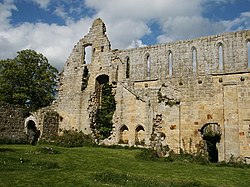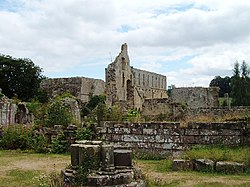Jervaulx Abbey: Difference between revisions
Created page with "{{Infobox monastery |name=Jervaulx |county=Yorkshire |riding=North |village=East Witton |picture=Jervaulx Abbey - geograph.org.uk - 12710.jpg |picture caption=Jervaulx Abbey r..." |
No edit summary |
||
| Line 21: | Line 21: | ||
|website=[http://www.jervaulxabbey.com/ jervaulxabbey.com] | |website=[http://www.jervaulxabbey.com/ jervaulxabbey.com] | ||
}} | }} | ||
'''Jervaulx Abbey''' in [[East Witton]] near the city of [[Ripon]], was one of the great | '''Jervaulx Abbey''' in [[East Witton]] near the city of [[Ripon]], was one of the great Cistercian abbeys of [[Yorkshire]], dedicated to St Mary in 1156. | ||
The name ''Jervaulx'' is a French derivation made popular in the romantic mood of the nineteenth century. The name is first attested as ''Jorvalle'' in 1145, from “Ure Vale”; the valley of the [[River Ure]].<ref>Eilert Ekwall, ''The Concise Oxford Dictionary of English Place-names'', p.268.</ref> The valley appears in earlier ages as ‘Yoredale’, though today it is known as [[Wensleydale]]. | The name ''Jervaulx'' is a French derivation made popular in the romantic mood of the nineteenth century. The name is first attested as ''Jorvalle'' in 1145, from “Ure Vale”; the valley of the [[River Ure]].<ref>Eilert Ekwall, ''The Concise Oxford Dictionary of English Place-names'', p.268.</ref> The valley appears in earlier ages as ‘Yoredale’, though today it is known as [[Wensleydale]]. | ||
Latest revision as of 12:37, 14 August 2015
| Jervaulx | |
|
Yorkshire | |
|---|---|
 Jervaulx Abbey ruins | |
| Location | |
| Grid reference: | SE171857 |
| Location: | 54°16’1"N, 1°44’16"W |
| Village: | East Witton |
| Order: | Savigniac, Cistercian |
| History | |
| Established: | 1156 |
| Mother house: | Byland Abbey |
| Founder: | Akarius fitz Bardolph |
| Dedication: | St Mary |
| Controlled churches: |
Aysgarth, Ainderby Steeple, East Witton, West Witton |
| Disestablished: | 1537 |
| Information | |
| Remains: | Substantial |
| Owned by: | Private |
| Website: | jervaulxabbey.com |
Jervaulx Abbey in East Witton near the city of Ripon, was one of the great Cistercian abbeys of Yorkshire, dedicated to St Mary in 1156.
The name Jervaulx is a French derivation made popular in the romantic mood of the nineteenth century. The name is first attested as Jorvalle in 1145, from “Ure Vale”; the valley of the River Ure.[1] The valley appears in earlier ages as ‘Yoredale’, though today it is known as Wensleydale.
History
Initially a Savigniac foundation out of Normandy, the abbey was later taken over by the Cistercian order from Burgundy and responsibility for it was taken by Byland Abbey. Originally founded in 1145 at Fors near Aysgarth, it was moved ten years later to a site a few miles away on the banks of the River Ure. In 1145, in the reign of King Stephen, Akarius Fitz Bardolph who was Lord of Ravensworth, gave Peter de Quinciano, a monk from Savigny, land at Fors and Worton, in Wensleydale to build a monastery of their order. The monastery there was successively called the Abbey of Fors, Jervaulx, and Charity. Grange, five miles west of Aysgarth, a hamlet in the township of Low Abbotside, in the parish of Aysgarth is the original site of Fors Abbey. After it was abandoned it was known by the name of Dale Grange and now by that of the Grange alone.[2]
Serlo, then Abbot of Savigny, disapproved of the foundation, as it had been made without his knowledge and consent. He refused to supply it with monks from his abbey because of the great difficulties experienced by those he had previously sent into England. He therefore, in a general chapter, proposed that it should be transferred to the Abbey of Belland (Byland) which was closer and would be able to lend the necessary assistance required by the new foundation. Monks were sent from Byland and after undergoing great hardships because of the meagreness of their endowment and sterility of their lands, Duke Conan of Brittany, son of Alan, 1st Earl of Richmond, greatly increased their revenues and, in 1156, removed their monastery to a better location in East Witton, the present situation.[3] Here the monks erected a new church and monastery, which, like most of the Cistercian order, was dedicated to St Mary. At the height of its prosperity the abbey owned half of the valley and was renowned for breeding horses, a tradition that remains in Middleham to the present day. It was also the original home of Wensleydale cheese.[4]
In 1279 Abbot Philip of Jervaulx was murdered by one of his monks. His successor, Abbot Thomas, was initially accused of the crime, but a jury later determined that he was not to blame, and another monk fled under outlawry.[5]
According to John Speede, at the dissolution the Abbey was valued at £455 10s. 5d. The last abbot, Adam Sedbergh, joined the Pilgrimage of Grace, and suffered death by hanging at Tyburn in June 1537.[6]

After the Reformation
The abbey was dissolved in 1537, and its last abbot, Adam Sedbar, was hanged for his part in the resultant rebellion, known as the Pilgrimage of Grace. The pulpitum screen with part of the stalls can now be seen at St. Andrew's parish church in Aysgarth, while a window was reused at St Gregory's parish church in Bedale.
The monasteries before dissolution were a major economic influence in their areas and major employers, so on dissolution the local people feared starvation, which triggered the rebellion in the northern shires. There was no immediate resolution to tenant sufferings, which had to await the reorganisation of landholdings by the purchase of former monastic lands across King Henry’s new nobility.
The standing remains of the abbey include part of the church and claustral buildings, as well as a watermill. The lordship of East Witton, with the site of the abbey, was granted by the King to Matthew Stuart, 4th Earl of Lennox, and Margaret, his wife, the king's niece, and after passing through various hands, the property came into the possession of the Bruce family, one of whom was created Earl of Ailesbury in 1805. The estate was purchased from the trustees of Ernest Brudenell-Bruce, 3rd Marquess of Ailesbury, in 1887, by S. Cunliffe Lister, Esq. of Swinton Park, for £310,000.[7]
The abbey site was purchased by Major and Mrs W V Burdon in 1971. Their youngest son, Ian, now runs the abbey, the ruins of which are open to the public.
Outside links
| ("Wikimedia Commons" has material about Jervaulx Abbey) |
References
- ↑ Eilert Ekwall, The Concise Oxford Dictionary of English Place-names, p.268.
- ↑ "The Dales :: Fors Abbey-Askrigg". www.thedales.org.uk. http://www.thedales.org.uk/ForsAbbey-Askrigg. Retrieved 2009-06-24.
- ↑ GENUKI: Jervaulx Abbey History
- ↑ A brief history of the rise and fall of Jervaulx Abbey - jervaulxabbey.com
- ↑ [http://www.isleofalbion.co.uk/jervaulx/ Isle of Albion: Jervaulx Abbey Picture Gallery
- ↑ Houses of Cistercian monks - Jervaulx
- ↑ Yorkshire history: Abbeys - yorkshirehistory.com
